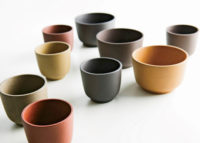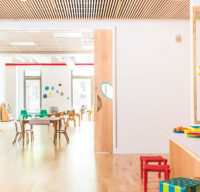Given the opportunity for a solo show in central Tokyo, most young architects would put their buildings on display. But Makoto Tanijiri, who founded the Hiroshima firm Suppose Design Office, is not like most architects. Instead of featuring stand-alone works, his recent exhibition, Tokyo Office, at the Prismic Gallery, displayed an entire work space. Desks, chairs, and a computer took the place of frames and pedestals, while concept sketches casually taped to the wall, binders of working drawings, study models, and other tools of the trade were as artfully arranged as a still-life painting.
The pristine presentation bears little resemblance to Tanijiri’s actual headquarters: a 270-square-foot studio apartment where his staff of 10 hunker down amid a maze of desks, model parts, and material samples. One of Hiroshima’s growing number of successful young practitioners, Tanijiri has completed a slew of projects, including an internal medicine clinic, a wedding chapel, a variety of commercial interiors, and a whopping 44 houses—not bad for a guy who admits he goofed off in school. Instead of entering a prestigious university followed by an apprenticeship with a well-known designer, Tanijiri attended a two-year technical college, then worked for a design-build firm where he picked up construction basics and enough training to qualify for his license. After five years, the 26-year-old architect left the company to launch his own venture in 2000. He spent his first year on his own competing in mountain-bike races while designing small interiors for friends on the side.
By his second year, bona fide building commissions started to roll in. But the media did not take notice until 2003, when Tanijiri completed Float, a combined restaurant and residence in a Hiroshima suburb. What garnered attention were the giant, triangulated steel frames Tanijiri used to straddle his client’s challenging, split-level site. “If you think positively about a difficult problem, you will find a way to solve it,” explains the architect.
Perhaps Tanijiri’s willingness to take on jobs that might make others shudder stems from his unorthodox training. Free from the overbearing influence of the strong mentor relationships that typically develop in Japanese universities and design offices, Tanijiri has a broad vision and writes his own rules. He does not favor any particular formal, structural, or material solutions—all are fair game. “Strong initial ideas yield strong buildings.” They result in good exhibitions, too. While the relaxed informality of Tokyo Office captured Tanijiri’s easygoing demeanor, its practical content projected his no-nonsense approach to problem solving. Poised to open a Tokyo branch office the day after the exhibition closed, Tanijiri planned simply to ship the contents of the show to the newly leased space where the displayed objects would revert to design tools, and drawings would turn back into reference materials.























Post a comment to this article
Report Abusive Comment